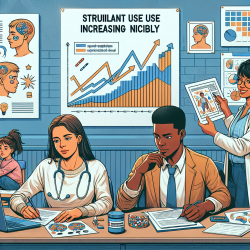Introduction
In the realm of pediatric therapy, understanding the nuances of medication trends is crucial for practitioners aiming to make data-driven decisions. The research article "Trends in use of prescription stimulants in the United States and Territories, 2006 to 2016" provides valuable insights into the evolving landscape of stimulant use, particularly in the treatment of Attention Deficit Hyperactivity Disorder (ADHD). This blog explores the findings of the study and discusses how practitioners can leverage this information to enhance their practice and outcomes for children.
Key Findings of the Study
The study highlights several important trends in stimulant use over the decade from 2006 to 2016:
- Amphetamine use increased 2.5 times, from 7.9 to 20.0 tons.
- Methylphenidate use peaked in 2012 and showed a modest decline by 2016.
- There were significant regional differences, with the Southern US showing over thirty-fold higher use of lisdexamfetamine compared to the Territories.
- States with larger Hispanic populations had significantly lower use of stimulants.
Implications for Practitioners
These findings have several implications for practitioners working with children diagnosed with ADHD:
- Regional Awareness: Practitioners should be aware of regional disparities in stimulant use, which may reflect differences in diagnostic practices, cultural attitudes, and access to non-pharmacological interventions.
- Cultural Sensitivity: Understanding the lower rates of stimulant use in states with larger Hispanic populations can guide culturally sensitive approaches to diagnosis and treatment.
- Non-Pharmacological Interventions: The increase in stimulant use underscores the need for practitioners to advocate for and implement evidence-based non-pharmacological interventions, such as behavioral therapy, which can complement medication.
Encouraging Further Research
While the study provides a comprehensive overview of stimulant use trends, it also highlights the need for further research to understand the underlying causes of regional and ethnic disparities. Practitioners are encouraged to engage in or support research efforts that explore:
- The impact of socio-economic factors on ADHD diagnosis and treatment.
- The effectiveness of non-pharmacological interventions across different populations.
- The long-term outcomes of stimulant use in children.
Conclusion
As practitioners dedicated to improving outcomes for children, it is essential to stay informed about trends in medication use and their implications. By integrating the insights from this study into practice, practitioners can better tailor their approaches to meet the diverse needs of their patients. For those interested in delving deeper into the research, the original paper can be accessed through the following link: Trends in use of prescription stimulants in the United States and Territories, 2006 to 2016.










